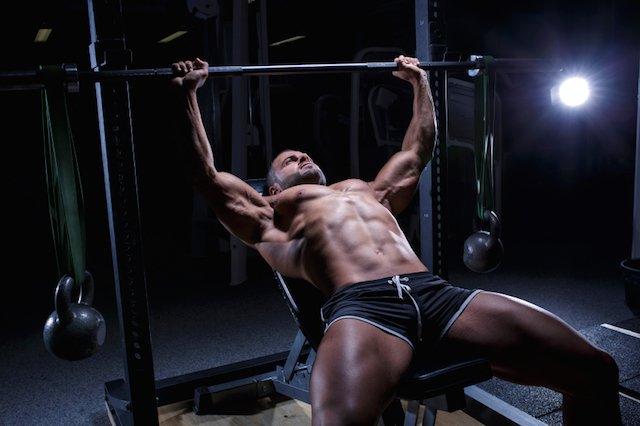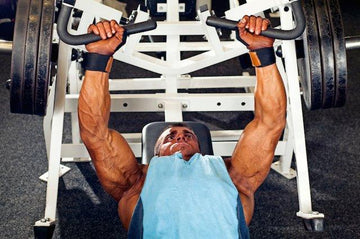

Why Bodybuilder's Should Use Bands for Muscle Mass
Table of Contents
Get Bigger by Using Bands
By: Robbie DurandIt is not uncommon to see many gyms to have bands and chains next to the squat racks and bench press. Bands and chains have traditionally been thought of as just for powerlifters, but bodybuilders can get tremendous benefit from the use of adding bands and chains to their workout routine. Using bands and chains is a form of variable resistance training that can add variety to your training routine. Variable resistance modes, such as bands and chains have been and are currently being supplemented into strength, power, and velocity training programs to elicit neuromuscular and possibly changes in muscle size. Studies have shown that combining elastic bands with free weights increases the resistance throughout the ascending movement – when the bands are being stretched the most, and similarly; the highest resistance will be provided at the beginning of the descending movement. Contrary, free weight squats would have lower activation in the upper portion of the movement as the moment torque about the knee would be less than in the lower portion.
Bands Increase Muscle Activation
Band-resisted ballistic and plyometric training such as the use of bench press bands and chains can be used to magnify the stretch shortening cycle, increasing the amount of eccentric potential energy stored in the involved musculotendon units, enhancing the rate of force and velocity development, and possibly power produced during the subsequent concentric phase. Think of your muscle as a rubber band, when you pull back the rubber band to its most stretched point it can store energy for it to get back to normal size again. When skeletal muscle is stretched during the eccentric portion of muscle contraction, the tendon lengthens, and the tendon is able to store energy like the rubber band and enables the muscle to spring back when it is contracted, like a rubber band.
Bands and Chains Beat Conventional Exercise for Strength
A previous study found that replacing some of the free weight resistance with elastic band resistance during bench press training resulted in greater increases in strength over a 13-week training period compared to bench pressing with traditional fixed resistance. The common features of variable resistance training machines are the presence of cables, pulleys, or other devices to create variability, coupled with the placement of the user in a fixed position to ensure that the user cannot recruit other muscle groups to assist in the completion of the prescribed movements.
Research Confirms Bands and Chains Boost Strength
The latest meta-analysis conducted in the Journal of Strength and Conditioning Research confirms that bands and chains are legit for increasing strength. The purpose of this study was to compare in a meta-analysis the effects of a long-term (>= 7 weeks) variable resistance training program using chains or elastic bands and a similar constant resistance program in both trained adults practicing different sports and untrained individuals. Seven studies involving 235 subjects fulfilled the selection and inclusion criteria. Variable resistance training led to a significantly greater mean strength gain than conventional weight training. An extra 5% increase in 1RM and thus 2x greater strength gains on the bench. An additional 11% increase in 1RM and thus 2.6x greater strength gains for squats. Long-term variable resistance training using chains or elastic bands attached to the barbell emerged as an effective evidence-based method of improving maximal strength both in athletes with different sports backgrounds and untrained subjects.

Blow Up Your Squats with Bands
Researchers just published a great study published in the Journal of Strength and Conditioning Research a new study titled, “ELECTROMYOGRAPHIC COMPARISON OF SQUATS USING CONSTANT OR VARIABLE RESISTANCE.” showing the benefits of adding some bands to your squat. Researchers had subject’s assigned to:
1) free weights,
2) free weights with two elastic bands (one at each side of the bar) and
3) free weights with four elastic bands.
The conditions were performed at the same intensity – 6-RM. The subject’s had electrodes hooked up all over their legs to measure the muscle activity during the lifts. At the end of the study, elastic bands induced higher neuromuscular activation in the upper and middle part of the movement, especially for the ascending phases. In the top ascending phase a high contribution of the load from elastic bands using (4 Bands) provided higher activation compared to a medium contribution (2 Bands). Interestingly, for the whole movement, a 12% higher activation of the biceps femoris (hamstrings) was observed for four elastic bands compared to free weights. The finding that the high variable resistance with bands was superior in the lower phases is likely explained by the fact that, in contrast to free-weight squats, there is little loading on the muscle in the bottom phase of the free-weight biceps curl. The result of the study suggests that adding elastic bands as variable resistance to free-weight squats increase the activation of the quadriceps and hamstring muscles, especially in the upper part of the ascending movement.
Key Points: Bands increase muscle activation compared to free weight exercise exercise. Bodybuilders should incorporate bands and chains into their training for increased muscle stimulation during exercise.
Soria-Gila MA, Chirosa IJ, Bautista IJ, Chirosa LJ, Salvador B. EFFECTS OF VARIABLE RESISTANCE TRAINING ON MAXIMAL STRENGTH: A META-ANALYSIS. J Strength Cond Res. 2015 May 8.
McMaster, D, Cronin, J, and McGuigan, M. Forms of variable resistance training. Strength and Conditioning Journal, 31(1): 50-64, 2009.
Anderson, C, Sforzo, G, and Sigg, J. The effects of combining elastic tension and free weight resistance on strength and power in athletes. Journal of Strength and Conditioning Research 22(2): 567-574, 2008.
Bellar, D, Muller, M, Barkley, J, Kim, C, Ida, K, Ryan, E, Bliss, M, and Glickman, E. The effects of combined elastic and free-weight tension on one-repetition maximum strength in the bench press. Journal of Strength and Conditioning Research 25(2): 459-463, 2011.
Wallace B, Winchester, J, and McGuigan, M. Effects of elastic bands of force and power characteristics during the back squat exercise. Journal of Strength and Conditioning Research 20(2): 268-272, 2006.
MUSCLE MEDIA MAGAZINE FOR MEN
The premier source of training, nutrition, supplements, fat loss and health for men.

















